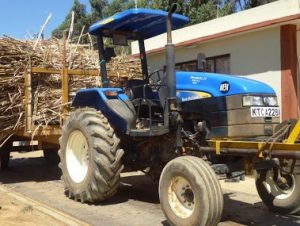
The collapse of Mumias Sugar Company has adversely affected the residents of Kakamega County as sugarcane farming has been their economic mainstay for a long time.
The factory was established in 1971 following the feasibility study report by the Booker Agriculture and Technical Services group that had been commissioned by the government in 1967 to carry out the exercise.
At that time the government held majority shares at 71 per cent while minority were held by the Commonwealth Development Corporation (17 per cent), Kenya Commercial Finance Company (5 per cent), Booker McConnell (4 per cent) and the East African Development Bank that had 3 per cent.
The Mumias area was at that time underdeveloped and land utilization was poor as farmers grew food crops on small areas for subsistence while the rest of the land was for grazing.
The miller’s production increased steadily hitting a climax in the 1980s and 1990s then becoming the leader in the East and Central Africa.
Its shares were listed on the Nairobi Stock Exchange in 2001 and the government shareholding reduced to 20 per cent.
However, the company’s production trajectory assumed a downward trend a few years later thanks to financial impropriety by the top managers.
According to the Chairman of the Board of Directors, Kennedy Ngumbau, the miller posted a net loss of Sh.15.1 billion in the financial year 2018/2019 against the previous year’s loss of Sh.6.8 billion.
This is happening despite the national government pumping into it more than Sh. 3.7 billion in a bailout plan.
Ngumbau said that the steep rise in the loss was driven by a 101 per cent increase in impairment charges to the firm’s plant and machinery.
The company owes the Kenya Revenue Authority Sh. 10 million while the Kenya Commercial Bank which appointed a receiver manager last month is owed Sh. 20 billion.
The Kakamega County Crops Officer (CCO), Titus Omengo says the cane growing enterprise has been left to the well-to-do who have substantial portions of land. He stated that smallholder farmers have turned to food crop farming for subsistence purposes.
“The emerging scenario is attributable to the fact that the large scale farmers have adequate land for cash and food crop growing as well as alternative sources of income,” he explained.
The CCO added that the farmers supply the cane to the private millers, West Kenya and Butali, which pay weekly for the deliveries at comparatively higher price of between Sh. 3,800 and 4,000. Per ton. The public factories, on the other hand, averagely pay farmers Sh. 3,200 per ton and they takes long to do so.
Halima Juma, a businesswoman in Kakamega town and a farmer in Navakholo Sub County, who owns five acres out of which three are under cane says she cannot stop undertaking the enterprise.
“Every acre produces 20 tonnes per harvest which translates to 60, multiplied by Sh. 3,800 it amounts to Sh. 228, 000 which is good money,” she observed saying after deducting expenses she is left with Sh. 200,000.
Halima praised the private factories for the timely harvesting and transportation of the produce as well as paying farmers. Harvesting is done after 18 months.
Another farmer, Abdalla Musa from East Wanga in Mumias East Sub County said he has a four-acre cane plantation and is contracted by Butali Sugar Mills. He said the proceeds from the cane enables him to pay household bills but however lamented that the pricing per ton is still low in the light of the ever rising cost of production.
Mr. Omengo said although most of the residents in Lurambi, Navakholo and the larger Mumias areas have abandoned sugarcane for food crops, those in Lugari and Likuyani are adopting the crop.
These areas are traditionally known for large scale maize production but currently huge chunks of land is being put under cane and this would have an implication on food security in the region.
Contacted by KNA, the

called on the government to address the issues of zoning, pricing and imports.
Esechere said they are against zoning of cane growing areas as this would curtail the farmers’ freedom to transact with any miller of their choice. He also suggested that the pricing should be based on the sucrose content and not the weight as is the case at the moment.
“The importation of sugar should be regulated in order to avoid flooding the market which negatively affects the pricing of the local sugar,” he opined.
The farmers’ lobby group official at the same time, proposed that the Sugar Directorate be decentralized to bring services closer to the stakeholders.
Recently, the County leaders under the stewardship of Governor Wycliffe Oparanya resolved to hold talks with national government on the revival of Mumias Sugar Company. They said with the substantial shareholding of 20 per cent at the miller, the national government is losing a lot and therefore should find a way of reviving the factory that stopped operations three years ago.
In a strategic meeting at the Bishop Stam Pastoral Centre on the fringes of Kakamega Town, the leaders called on the relevant state agencies to apprehend and prosecute the individuals who looted the factory coffers.
They also agreed to collaborate with the national government in the provision of security for the company’s premises and other assets. “We are going to engage the Kenya Commercial Bank to recall the receiver manager they appointed last month,” said Oparanya who was the group’s spokesperson.
They also expressed concern that the miller was owed Sh1 billion by defaulters who they requested to clear their debts to revive the firm. “Our appeal to the company’s creditors is that they be a little more patient so that once the miller resumes crushing and stabilizes financially, they will be paid,” he stated.
Meanwhile, the county government intends to set aside funds for cane development in this year’s supplementary budget.
By Sammy Mwibanda




